It’s winter in Maryland. In fact, it’s so much winter I shoveled 10 inches of snow off my driveway this morning. Fortunately, I had company. It wasn’t the kind of company that picks up a shovel and helps out, but still, the American robins darting back and forth over my head were still welcome (if surprising and surprisingly quiet) snow day companions.
Become a Member
Make a lasting impact for nature when you join The Nature Conservancy
“You know,” I said to them as I leaned on my shovel to watch about 25 birds flock together in my neighbor’s oak. “I think y’all are a little early—aren’t you supposed to be the first harbingers of spring?”
We’re not even a month past the first day of winter in the northern hemisphere. Spring is definitely not here. So why are the robins? Shouldn’t they be sunning themselves in warmer climes?
The short answer: as long as there’s food, American robins—true to their name Turdus migratorius (“the wandering thrush”)—kind of spend their winters coming and going as they please.
Robin Migration (AKA Robin Wandering)
Robins do migrate—but they don’t necessarily follow a more or less straight line from north to south in the fall, then repeat the journey south to north in the spring. In the fall and winter, when the ground freezes, robins lose access to their meal of choice: worms, insects (adult and larval) and (occasionally) snails. That’s when they turn to their winter diet staple: mostly fruit, mostly berries.
The folks at Journey North, a project tracking robin movements run by the University of Wisconsin-Madison, put it this way, “Some robins retreat all the way to southern Texas and Florida (in fact, some of the largest winter flocks documented by the Christmas Bird Count gather in sunny St. Petersburg, Florida), but others winter as far north as they can find berries. So they have an enormous winter range. Robins do migrate, but it has more to do with food sources than with being faithful to the same places year over year.”
In that way American robins are somewhat akin to teenage boys—they tend to go where the best (or most abundant or most easily accessible) food is, stay until it’s depleted, and then move on.
So as long as there are enough berries and other fruits to sustain them, you may see robins off and on throughout the winter across much of North America.
Forget the birdseed though. Robins’ digestive systems, unlike sparrows or other so-called feeder birds, aren’t built for dealing with seed, and their beaks aren’t built for cracking things open. Robin beaks are built for snapping up worms, catching insects, and plucking berries and other fruits. In the winter, a flock of robins can strip a holly bush with impressive speed and efficiency, and very little—if any—violent robin-on-robin aggression.
Food is also one of the reasons that robins, notoriously territorial and aggressive in breeding season, tend to gather and travel in flocks in the fall and winter. Numbers are good for defense, and also for spotting food—if one robin happens on a holly tree full of bright, ripe berries, the whole flock can partake. And then move on.
The tendency of robins to flock in winter may also be one of the reasons people seem to notice them—birds in large numbers tend to stand out when they’re gathered in leafless trees. (That and the beautiful red breast that is sometimes the only splash of color in a winter landscape that looks practically lunar in relentless shades of February white and gray.)
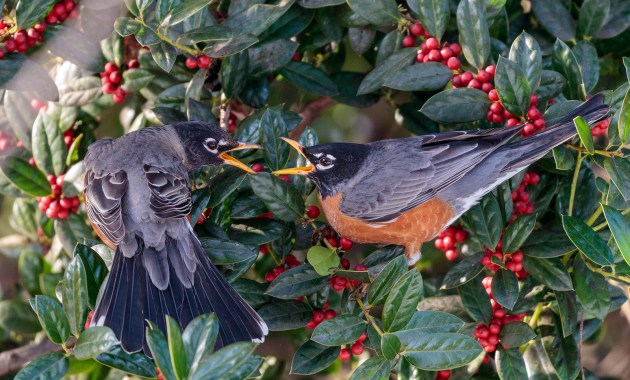
How do Robins Survive the Cold?
Robins are outfitted to survive huge temperature variances. In fact, hot weather seems to stress them more than cold.
If an American robin is healthy, has enough to eat, and is able to main its feathers, the temperature next to its body stays around 104 F—regardless of how cold it is in the world outside. It really is all about those feathers. (And the legs and feet.)
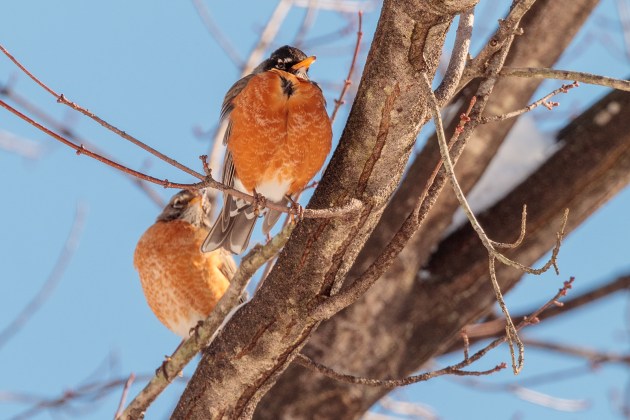
Robins, like most birds, have layers of feathers that perform different functions. When temperatures drop, robins puff the fine, downy feathers closest to their bodies to keep heat in, cold out. The outer feathers act like a kind of overcoat, shedding water and moisture and helping to regulate the bird’s temperature. (It’s an adaptation not limited to robins. Most birds with down feathers fluff them to regulate body heat).
The anatomy of a robin’s (and other bird species) also contributes to their cold adaptations. The bird experts over at the Cornell Lab explain it very well. The simplified version is that “most birds don’t succumb to frostbite because there is so little fluid in the cells of their feet, and their feet are mostly tendons and bones with little muscle or nerve tissue.”
So while blood does flow to their legs and feet, most birds (including robins) benefit from a very fast circulatory system and a “countercurrent heat exchange system.” Because bird legs are thin, the vessels that move blood from the heart to the feet and back again are very close together. That proximity means, per Cornell, “blood flowing back to the body is warmed by blood flowing to the feet. The newly cooled blood in the feet lowers heat loss from the feet, and the warmed blood flowing back into the body prevents the bird from becoming chilled.”
Robins: The Tell-Tale Birds of Spring
If robins are around in winter, why have they always been associated with the beginning of spring in the U.S.? Most likely it has to do with ground thaw, snow melt, and territorial behaviors like singing, worm hunting and nest building. But mostly, it’s the singing.
According to Journey North, which has a fantastic Q+A section I highly recommend for the robin-curious, “the robin’s song remains a reliable indicator that the first wave of spring migration has reached you. This song is one of the first signs that robins are switching from winter behavior to courtship and nesting behaviors associated with spring.”
Robins tend to move north as the ground thaws. The availability of high protein prey, especially worms that emerge with warmer, often wetter weather, is when a robin’s thoughts turn to procreation. And that’s the end of the cooperative fall and winter behaviors.
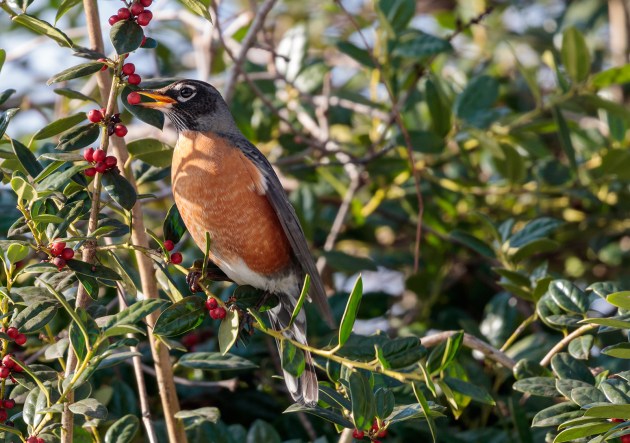
Which is one of the reasons many robins (primarily males) may stay through harsher winters instead of booking it to St. Petersburg: first access to the choicest nesting grounds. Breeding season is when robins also become more visible with mating displays, nest-building and a lot of time on the ground hunting for the tastiest worms. Until then, they’re all about the berries.
You Can Help Robins with Science from Your Own Backyard
Like many species, including other birds, scientists are starting to see some changes in robin behavior that is likely attributable to climate change. One study of American robins migrating to and from Canada’s boreal forest, showed that they’re beginning to journey south on average about 12 days earlier than in past years, or five days earlier per decade since 1994.
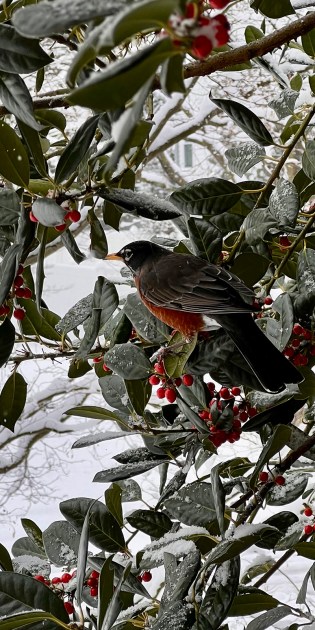
If you want to help scientists studying birds, there are several ways to contribute your observations (not just for robins, but for many of the species you can see outside your windows).
Journey North
You can submit your robin observations directly on the Journey North site (and check out their other migration-related citizen science projects). They also have 2025 maps tracking sightings so you can see where American robins (and other signs of spring) are being observed and follow along (and contribute to) the wanderings of Turdus migratorius.
Cornell Lab of Ornithology
The Cornell Lab has a number of different ways you can contribute to science for birds. Your sightings tracked on eBird (free) contribute to worldwide data for birding, science, and conservation. Want to know what birds are being seen in your neighborhood, eBird has a feature for that. If you’re new to birding, check out their genius birding ID app, Merlin.
You can also contribute to Project FeederWatch (requires subscription) by counting birds at your feeder from November through April. Your observations help scientists monitor changes in the abundance and distribution of birds, including the influence of changes in habitat, disease, and climate.
And mark your calendars for the 2025 Great Backyard Bird Count (February 14-17). Spend time in your favorite places watching birds—then report them to Cornell! It’s easy to participate, “in as little as 15 minutes notice the birds around you. Identify them, count them, and submit your counts to help scientists better understand and protect birds around the world. You can see the results from 2024 here.
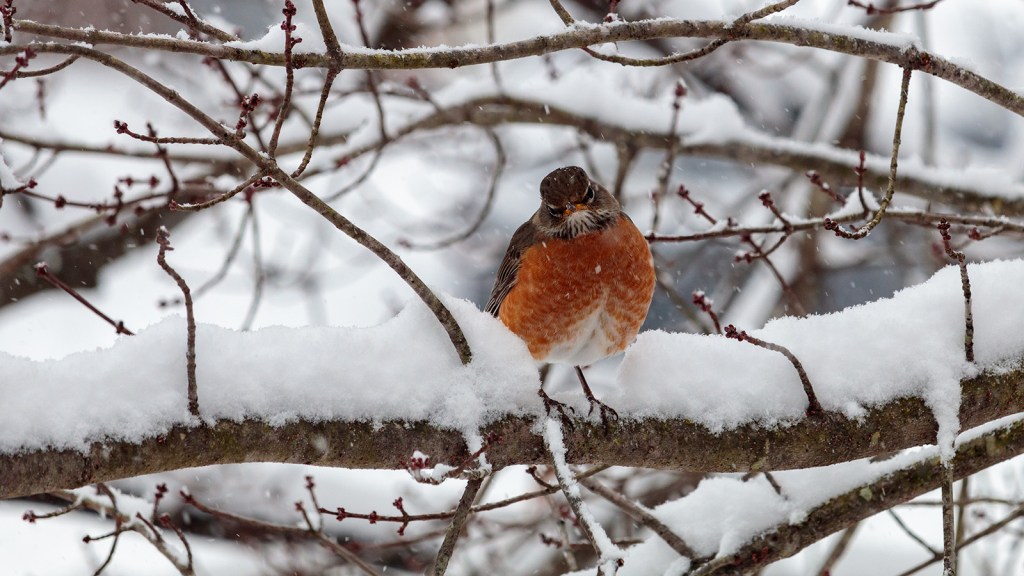



This was helpful information. There have been several “fat” robins all over the place in my yard.
We have had two or three land in our back yard looking for food. We have snow on the ground so we scattered some crumbled crackers out for them. Looked like males, red bellies. I was worried about them, we have coldest temps and treacherous conditions ever in Texas. I live near Dallas, my sister lives in Burleson, Texas and she saw droves of them eating red berries on shrubs.
I’ve lived in Texas all of my 61 years. When I was a child, I remember seeing robins every spring in my northeast Texas town. I moved to Dallas as an adult, and I’ve seen fewer and fewer robins over the years. It has become exciting to see one. Yesterday, during this crazy winter we’re having, an entire flock appeared in our neighborhood! They are EVERYWHERE! I wonder what brought them here this year. So exciting!
Had a massive flock of Robins mixed with Waxwings yesterday feeding off the last berries on a lugustrom bush/tree that the Waxwings had not stripped the last few weeks. I’m in Fort Worth, Texas, sw side of town. And, the date was 2/16/21.
About a week ago we saw at least 100 of them in our yard and wondering why they were here so soon. We also observed that we hear lots of bird sounds in the last month that is not normal for around our parts!
We have a large flock on ridgecrest dr alb nm 87108
I live in Keller , Texas. We just had the worst snow storm in 10 years (Down to 0 ) I looked out in my backyard by a Yaupon Holly tree and there were 50 robins in the tree eating those red berry’s . I was so shocked. Never seen that many robins . We see the cedar waxwings come in and clean the trees in less than a hour ,but this was amazing. Then I read this article – understand now – I have been feedings all the birds and giving them water about every 3 hours because it freezes Thank you
Im in Tulsa Oklahoma and about two weeks ago I started seeing alot of them.
I live in Fort Worth, TX and we are in the middle of an ice, snow and low-temperature winter storm. As such, there has been an increase in Robin sightings. It is such a nice surprise to look out the window and see such beautiful birds. We are, at the present moment, homebound because of the icy roads. If not, we may not have noticed the influx. There really is a silver lining to everything.
I reported to Journey North. Edmond, Oklahoma had sub zero temps one day of wind chill -31. A large group of robins were in our trees, flying around and around, attempting to roost, but could not. This went on for also the next day. The robins would puff out their feathers, and had labored breathing. It was hard to watch.
I saw a tree full of robins the other day in North Dallas! A guy and his dog walked by and they all scattered and then settled down again! I took a video on my phone I can send it to you if possible!
Also had 5 robins on our feeder/birdbath area the other day! Such a surprise.
Couple of weeks ago flock stayed in my front yard almost undeterred and neither people or cats moved them, I do have 3 Bradford pear trees.. they made a mess, spreading leaves and berries.. since then I’ve seen an occasional one
For the last two days during these frigid temps,I have watched dozens of robins descend on my holly bushes,which have been picked clean of holly berries. I should have videoed it but was too busy watching them. Must have been really hungry !
I live in Blue Springs, MO. Boy, it is cold. A couple of days ago I saw a robin, just one. Then this morning, it was next to my house, just one. It didn’t fly off, it just ran along the front of the house. I just felt bad for it. Because it’s cold outside. Will robins eat those dried worms you can buy in the store?
On Feb 7 of this year, in a snowstorm, I had a flock of robins arrive at my privet hedge. For the next 2 hours they proceeded to strip my huge holly of all its berries. It was amazing to watch!
A week later Facebook posted a memory that I had posted 4 years earlier documenting a similar situation.
I live in Southwestern CT.